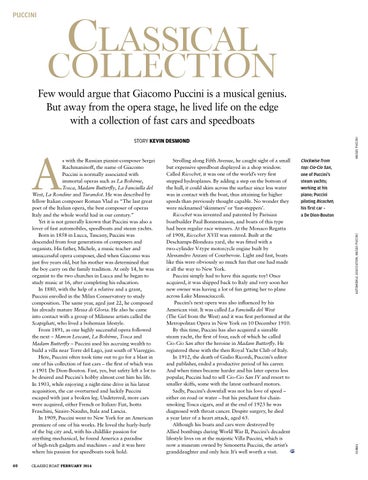cLASSIcAL
PUCCINI
cOLLecTIOn
60
CLASSIC BOAT FEBRUARY 2014
Strolling along Fifth Avenue, he caught sight of a small but expensive speedboat displayed in a shop window. Called Ricochet, it was one of the world’s very first stepped hydroplanes. By adding a step on the bottom of the hull, it could skim across the surface since less water was in contact with the boat, thus attaining far higher speeds than previously thought capable. No wonder they were nicknamed ‘skimmers’ or ‘fast-steppers’. Ricochet was invented and patented by Parisian boatbuilder Paul Bonnemaison, and boats of this type had been regular race winners. At the Monaco Regatta of 1908, Ricochet XVII was entered. Built at the Deschamps-Blondeau yard, she was fitted with a two-cylinder V-type motorcycle engine built by Alessandro Anzani of Courbevoie. Light and fast, boats like this were obviously so much fun that one had made it all the way to New York. Puccini simply had to have this aquatic toy! Once acquired, it was shipped back to Italy and very soon her new owner was having a lot of fun getting her to plane across Lake Massaciuccoli. Puccini’s next opera was also influenced by his American visit. It was called La Fanciulla del West (The Girl from the West) and it was first performed at the Metropolitan Opera in New York on 10 December 1910. By this time, Puccini has also acquired a sizeable steam yacht, the first of four, each of which he called Cio-Cio San after the heroine in Madam Butterfly. He registered these with the then Royal Yacht Club of Italy. In 1912, the death of Giulio Ricordi, Puccini’s editor and publisher, ended a productive period of his career. And when times became harder and his later operas less popular, Puccini had to sell Cio-Cio San IV and resort to smaller skiffs, some with the latest outboard motors. Sadly, Puccini’s downfall was not his love of speed – either on road or water – but his penchant for chainsmoking Tosca cigars, and at the end of 1923 he was diagnosed with throat cancer. Despite surgery, he died a year later of a heart attack, aged 65. Although his boats and cars were destroyed by Allied bombings during World War II, Puccini’s decadent lifestyle lives on at the majestic Villa Puccini, which is now a museum owned by Simonetta Puccini, the artist’s granddaughter and only heir. It’s well worth a visit.
Clockwise from top: Cio-Cio San, one of Puccini’s steam yachts; working at his piano; Puccini piloting Ricochet; his first car – a De Dion-Bouton
AUtoMoBILE AssoCIAtIoN, MUsEo pUCCINI
A
s with the Russian pianist-composer Sergei Rachmaninoff, the name of Giacomo Puccini is normally associated with immortal operas such as La Bohème, Tosca, Madam Butterfly, La Fanciulla del West, La Rondine and Turandot. He was described by fellow Italian composer Roman Vlad as “The last great poet of the Italian opera, the best composer of operas Italy and the whole world had in our century.” Yet it is not generally known that Puccini was also a lover of fast automobiles, speedboats and steam yachts. Born in 1858 in Lucca, Tuscany, Puccini was descended from four generations of composers and organists. His father, Michele, a music teacher and unsuccessful opera composer, died when Giacomo was just five years old, but his mother was determined that the boy carry on the family tradition. At only 14, he was organist to the two churches in Lucca and he began to study music at 16, after completing his education. In 1880, with the help of a relative and a grant, Puccini enrolled in the Milan Conservatory to study composition. The same year, aged just 22, he composed his already mature Messa di Gloria. He also he came into contact with a group of Milanese artists called the Scapigliati, who lived a bohemian lifestyle. From 1891, as one highly successful opera followed the next – Manon Lescaut, La Bohème, Tosca and Madam Butterfly – Puccini used his accruing wealth to build a villa near Torre del Lago, just south of Viareggio. Here, Puccini often took time out to go for a blast in one of his collection of fast cars – the first of which was a 1901 De Dion-Bouton. Fast, yes, but safety left a lot to be desired and Puccini’s hobby almost cost him his life. In 1903, while enjoying a night-time drive in his latest acquisition, the car overturned and luckily Puccini escaped with just a broken leg. Undeterred, more cars were acquired, either French or Italian: Fiat, Isotta Fraschini, Sizaire-Naudin, Itala and Lancia. In 1909, Puccini went to New York for an American premiere of one of his works. He loved the hurly-burly of the big city and, with his childlike passion for anything mechanical, he found America a paradise of high-tech gadgets and machines – and it was here where his passion for speedboats took hold.
CorBIs
story kevin desmond
MUsEo pUCCINI
Few would argue that Giacomo Puccini is a musical genius. But away from the opera stage, he lived life on the edge with a collection of fast cars and speedboats
